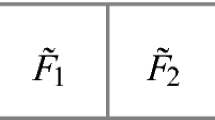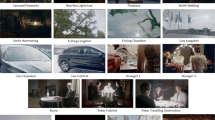Abstract
During video transmission different errors can occur, which can introduce distinct artifacts in video received at the end user side. One of the most common artifacts that appears in such cases is frame freezing and it can significantly reduce the quality of received video, i.e. decrease the level of end user Quality of Experience (QoE). Thus it is necessary to properly detect the occurrence of frame freezing, in order to assure the satisfactory level of end user QoE. In this paper a novel no-reference (NR) objective algorithm for detection of various types of freezing artifacts in video, called Histogram-Based Freezing artifacts Detection Algorithm (HBFDA), is proposed. HBFDA uses method for comparison of consecutive video frames, which consists of splitting frame into regions and comparing regions’ histograms of consecutive frames. In order to operate on different types of video contents (including those containing a low level of movement), while achieving high level of accuracy and reliability, HBFDA dynamically adapts its parameters in real-time. HBFDA performance are compared to this of two freely pulbicly available algorithms for frame freezing detection on videos from three different databases: VQEG HDTV, LIVE Mobile and newly created UHD Video Freezing Database (UHD VFD), which we made publicly available to the research community and it can be downloaded at http://www.rt-rk.com/other/UHDVideoDBReadme.html. Experimental results show that HBFDA has lowest number of false freezing detections when compared to other tested algorithms and that it achieves the highest average total accuracy of 99.26% when all databases are taken into account. Additionally, for UHD videos, HBFDA is able to process 75 frames per second, which makes it suitable for real-time video applications.





Similar content being viewed by others
References
Asha V, Bhajantri NU, Nagabhushan P (2011) GLCM–based chi–square histogram distance for automatic detection of defects on patterned textures. Int J Comput Vis Robot 2:302–313
AWS Elemental - 4K Test Sequences (2017) In: AWS Elem. - 4K Test Seq. http://www.elemental.com/resources/4k-test-sequences. Accessed 28 Apr 2017
Baldi M, Ofek Y (2000) End-to-end delay analysis of videoconferencing over packet-switched networks. IEEEACM Trans Netw 8:479–492. https://doi.org/10.1109/90.865076
Borer S (2010) A model of jerkiness for temporal impairments in Video transmission. In: 2010 second international workshop on quality of multimedia experience (QoMEX). IEEE: 218–223
Dagum L, Menon R (1998) OpenMP: an industry standard API for shared-memory programming. IEEE Comput Sci Eng 5:46–55. https://doi.org/10.1109/99.660313
FFmpeg (2018) https://www.ffmpeg.org/. Accessed 3 Feb 2018
Huynh-Thu Q, Ghanbari M (2008) Temporal aspect of perceived quality in Mobile Video broadcasting. IEEE Trans Broadcast 54:641–651. https://doi.org/10.1109/TBC.2008.2001246
Huynh-Thu Q, Ghanbari M (2009) No-reference temporal quality metric for video impaired by frame freezing artefacts. Proc - Int Conf Image Process ICIP: 2221–2224. doi:https://doi.org/10.1109/ICIP.2009.5413894
International Telecommunication Union (2008) ITU-T recommendation P.910, Subjective Video quality assessment methods for multimedia applications
Joshi P, Prakash S (2017) Retina inspired no-reference image quality assessment for blur and noise. Multimed Tools Appl 76:18871–18890. https://doi.org/10.1007/s11042-017-4418-2
van Kester S, Xiao T, Kooij RE, et al (2011) Estimating the impact of single and multiple freezes on Video quality. SPIE Proc. Int Soc Optics Photo
Lamb AB, Khambete M (2018) No-reference perceived image quality measurement for multiple distortions. Multimed Tools Appl 77:8653–8675. https://doi.org/10.1007/s11042-017-4761-3
Marziliano P, Dufaux F, Winkler S, Ebrahimi T (2002) A no-reference perceptual blur metric. Proceedings. International Conference on Image Processing
Mittal A, Saad MA, Bovik AC (2016) A completely blind Video integrity Oracle. IEEE Trans Image Process 25:289–300. https://doi.org/10.1109/TIP.2015.2502725
Moorthy AK, Choi LK, Bovik AC, de Veciana G (2012) Video quality assessment on Mobile devices: subjective, behavioral and objective studies. IEEE J Sel Top Signal Process 6:652–671. https://doi.org/10.1109/JSTSP.2012.2212417
Moorthy AK, Choi LK, De Veciana G, Bovik A (2012) Mobile Video quality assessment database. In: IEEE ICC workshop on realizing advanced Video optimized Wirel Netw: 652–671
Moorthy AK, Choi LK, De Veciana G, Bovik AC (2012) Subjective analysis of video quality on mobile devices. Sixth International Workshop on Video Processing and Quality Metrics for Consumer Electronics (VPQM), Scottsdale, Arizona
Muijs R, Kirenko I (2005) A no-reference blocking artifact measure for adaptive video processing. In: 2005 13th European signal processing conference: 1–4
OpenCV (2018) Histogram Comparison. https://docs.opencv.org/trunk/d8/dc8/tutorial_histogram_comparison.html. Accessed 30 Jan 2018
OpenCV (2018) https://opencv.org/. Accessed 21 Apr 2018
Pastrana-Vidal RR, Gicquel JC, Colomes C, Cherifi H (2004) Sporadic frame dropping impact on quality perception. In: human vision and electronic imaging IX. International Society for Optics and Photonics: 182–194
Qi Y, Dai M (2006) The effect of frame freezing and frame skipping on video quality. In: intelligent information hiding and multimedia signal processing, 2006. IIH-MSP’06. International conference on. IEEE: 423–426
Ruderman DL (1994) The statistics of natural images. Netw Comput Neural Syst 5:517–548. https://doi.org/10.1088/0954-898x_5_4_006
Shahid M, Rossholm A, Lövström B, Zepernick H-J (2014) No-reference image and Video quality assessment: a classification and review of recent approaches. EURASIP J Image Video Process 2014:40
Škobić V, Marić U, Tomić S, Rešetar I (2016) Real time Video freezing detection implementation on FPGA. In: telecommunications forum (TELFOR), 2016. IEEE: 1–3
Teslic N, Zlokolica V, Pekovic V et al (2010) Packet-loss error detection system for DTV and set-top box functional testing. IEEE Trans Consum Electron 56:1311–1319. https://doi.org/10.1109/TCE.2010.5606264
Ultra Video Group (2018) http://ultravideo.cs.tut.fi/#testsequences. Accessed 30 Jan 2018
Usman MA, Usman MR, Shin SY (2015) The impact of temporal impairment on quality of experience (QOE) in Video streaming: a no reference (NR) subjective and objective study. Int J Comput Electr Autom Control Inf Eng 9:1570–1577
Usman MA, Usman MR, Shin SY (2016) A no reference method for detection of dropped Video frames in live Video streaming. In: eighth international conference on ubiquitous and future networks (ICUFN). IEEE: 839–844
Usman MA, Shin SY, Shahid M, Lövström B (2016) A no reference Video quality metric based on jerkiness estimation focusing on multiple frame freezing in Video streaming. IETE Tech Rev 1–12. doi:https://doi.org/10.1080/02564602.2016.1185975
Usman MA, Usman MR, Shin SY (2018) A novel no-reference metric for estimating the impact of frame freezing artifacts on perceptual quality of streamed videos. IEEE Trans Multimed 1–1. doi:https://doi.org/10.1109/TMM.2018.2801722
Video Quality Experts Group (2010) Report on the validation of video quality models for high definition video content
Vranješ M, Rimac-Drlje S, Grgić K (2013) Review of objective Video quality metrics and performance comparison using different databases. Signal Process Image Commun 28:1–19. https://doi.org/10.1016/j.image.2012.10.003
Wolf S (2009) A no reference (NR) and reduced reference (RR) metric for detecting dropped video frames. Fourth Int workshop VIDEO process Qual Metr Consum Electron 15–16
Xue Y, Erkin B, Wang Y (2015) A novel no-reference Video quality metric for evaluating temporal jerkiness due to frame freezing. IEEE Trans Multimed 17:134–139. https://doi.org/10.1109/TMM.2014.2368272
Yammine G, Wige E, Simmet F et al (2012) Blind frame freeze detection in coded videos. 2012 Pict coding Symp PCS 2012 proc 341–344. doi:https://doi.org/10.1109/PCS.2012.6213315
Zhao S, Jiang H, Liang C, Sherif S (2016) Mathematical models for quality analysis of Mobile Video. Int J Numer Anal Model 13:879–897
Zlokolica V, Pekovic V, Teslic N, et al (2011) Video freezing detection system for end-user devices. Dig Tech Pap - IEEE Int Conf Consum Electron 81–82. doi:https://doi.org/10.1109/ICCE.2011.5722883
Acknowledgements
This work was supported by the Josip Juraj Strossmayer University of Osijek IZIP-2016, via the project “Providing of digital video signal based services in rural and rarely populated areas” and by the Ministry of Education, Science and Technological Development of the Republic of Serbia, under grant number III_044009_6.
Author information
Authors and Affiliations
Corresponding author
Additional information
Publisher’s Note
Springer Nature remains neutral with regard to jurisdictional claims in published maps and institutional affiliations.
Rights and permissions
About this article
Cite this article
Babić, D., Stefanović, D., Vranješ, M. et al. Real-time no-reference histogram-based freezing artifact detection algorithm for UHD videos. Multimed Tools Appl 78, 17949–17971 (2019). https://doi.org/10.1007/s11042-019-7184-5
Received:
Revised:
Accepted:
Published:
Issue Date:
DOI: https://doi.org/10.1007/s11042-019-7184-5




